Christies, “Salvator Mundi — The rediscovery of a masterpiece: Chronology, conservation, and authentication”
Leonardo da Vinci’s Salvator Mundi is one of the greatest and most unexpected artistic rediscoveries of the 21st century. Its illustrious 500-year history, and the story of its re-emergence, restoration and authentication, is as fascinating as any of the bestselling thrillers about Leonardo’s life and times.
Around 1500
Leonardo paints Salvator Mundi possibly for King Louis XII of France and his consort, Anne of Brittany. It is most likely commissioned soon after the conquests of Milan and Genoa.
Expert opinion varies slightly on the dating. Most consulting scholars place the painting at the end of Leonardo’s Milanese period in the later 1490s, contemporary with The Last Supper. Others believe it to be slightly later, painted in Florence (to where the artist moved in 1500), contemporary with the Mona Lisa. Like several of Leonardo’s later paintings, the Salvator Mundi is probably executed over a period of years.
1625
French princess Henrietta Maria marries King Charles I of England (1600-1649), the greatest picture collector of his age. It has been speculated that she brings the painting to England, whereupon it hangs in the private chambers at her palace in Greenwich until, with Civil War looming, she flees England in 1644.
Charles I of England, the greatest art collector of his age, and Henrietta Maria, who is thought to have brought the painting to England from France upon becoming his queen consort in 1625. Painting by Anthony van Dyck. Palazzo Pitti, Florence, Italy / Bridgeman Images
1650
The celebrated printmaker Wenceslaus Hollar — a Royalist who also escaped England in the 1640s — publishes a print based on an earlier drawing he had made of the painting, which itself is recorded in the inventory of the royal collection (‘A peece of Christ done by Leonardo at 30:00:00’). The inventory is compiled in fulfilment of an act of Parliament dated 23 March 1649, which requires the sale of the king and queen’s property to meet the debts of their creditors and for the ‘publick uses of this Commonwealth’.
Hollar signs and dates his etching, inscribing it ‘Leonardus da Vinci pinxit’, Latin for ‘Leonardo da Vinci painted it’. The print itself is published in Antwerp and proof copies are sent to the queen in exile.
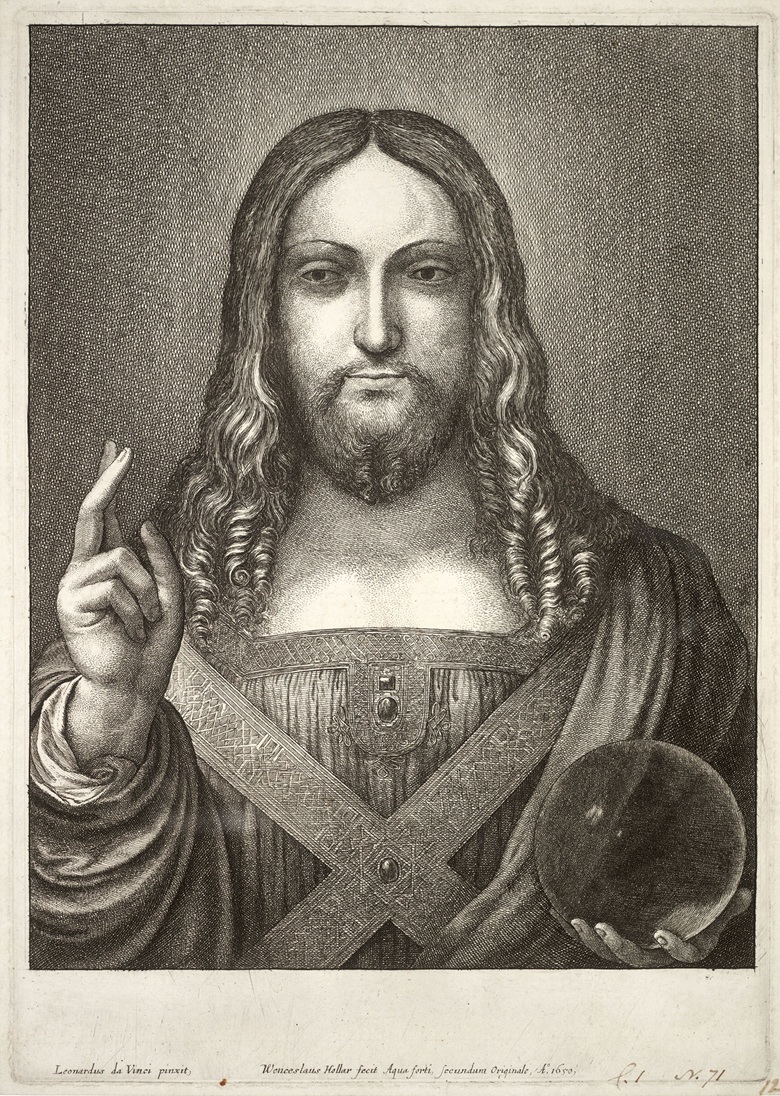
Jesus after Leonardo (state 1) by Wenceslas Hollar, including the artist’s inscription in Latin: ‘Leonardus da Vinci pinxit’ (‘Leonardo da Vinci painted it’). Artwork form U. of Toronto Wenceslas Hollar Digital Collection
1651
An inventory records that the painting is sold at the ‘Commonwealth Sale’ on 23 October to John Stone, a mason (in modern terms an architect or builder) who was representative of a group of creditors who received it and other paintings in repayment of debts.
1660
Charles II is restored to the throne and his late father’s possessions are recalled by an act of Parliament. Stone returns the painting to the Crown.
1666
An inventory of the collection of King Charles II at Whitehall lists it among the select paintings in the king’s closet, as item 311: ‘Leonard de Vince O.r. Savio.r w.th. a gloabe in one hand and holding up y.e other’.
Charles II is restored to the throne in 1660 and his late father’s possessions, including the painting by Leonardo, are recalled by an act of Parliament. Portrait by Godfrey Kneller. Kenwood House, London, UK © Historic England / Bridgeman Images
1685 to late 18th century
The picture very probably remains at Whitehall during the reign of Charles II’s successor, James II (1685-88), passing to his mistress, Catherine Sedley, Countess of Dorchester (1657-1717), and then by descent until the late 18th century.
1900
Having vanished for around 200 years, the painting surfaces when it is acquired from Sir Charles Robinson as a work by Leonardo’s follower, Bernardino Luini, for the Cook Collection, Doughty House, Richmond. By this time, the walnut panel on which it is painted has been marouflaged and cradled and Christ’s face and hair have been extensively overpainted.
1909
The architect Leon Benois exhibits the Madonna and Child with Flowers by Leonardo, a painting previously thought lost, in St Petersburg. Now in the Hermitage, St. Petersburg, The Benois Madonna, as it is now known, remains the last Leonardo painting to have emerged for almost 100 years.
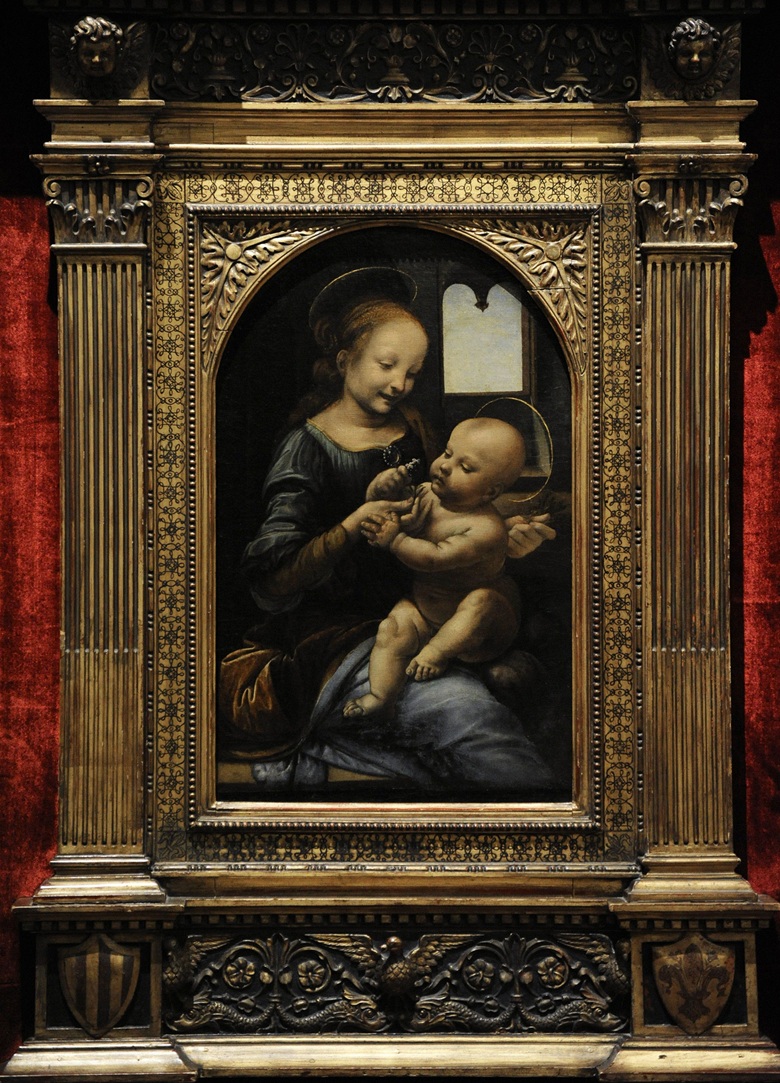
The previous painting by Leonardo to come to light — Madonna and Child with Flowers, known as the Benois Madonna, which was exhibited in St Petersburg in 1909. akg-images / Album / Prisma
1913
In his catalogue of the Italian paintings in the Cook Collection, Tancred Borenius describes the present painting as a ‘free copy after Boltraffio’ (another pupil of Leonardo’s). Sir Herbert Cook, however, notes that he sees higher quality in it.
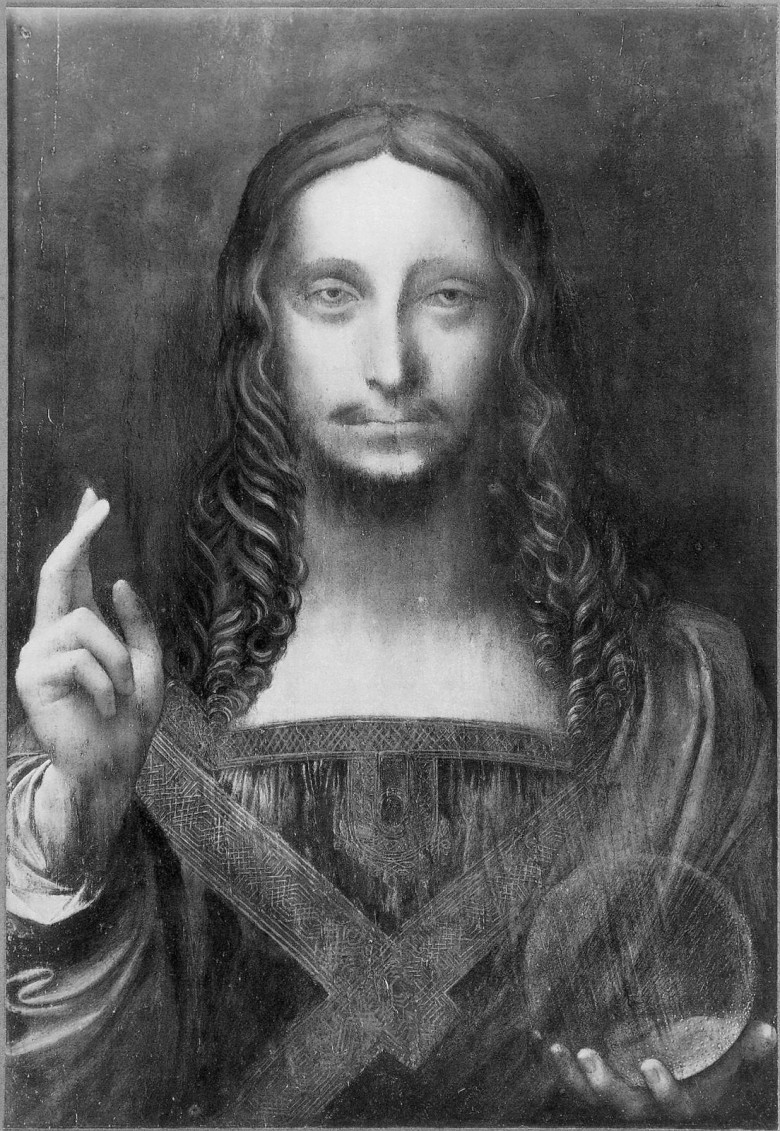
Salvator Mundi in the Cook Collection
1958
In the dispersal of the Cook Collection Salvador Mundi — concealed by overpainting — is ultimately consigned to a sale at auction where it fetches £45. It then disappears once again for nearly 50 years.
2005
The painting is discovered — masquerading as a copy — in a regional auction in the United States. After acquiring it from an American estate, its new owners move forward with care and deliberation in cleaning and restoring the painting, researching and thoroughly documenting it, and cautiously vetting its authenticity with the world’s leading authorities on the works and career of the Milanese master.
2007
A comprehensive restoration of the Salvator Mundi is undertaken by Dianne Dwyer Modestini, Senior Research Fellow and Conservator of the Kress Program in Paintings Conservation at the Conservation Center of the Institute of Fine Arts, New York University. Modestini explains that the original walnut panel on which Leonardo, who was known for his use of experimental material, executed Salvator Mundi contained a knot which had split early in its history. However, she concludes that important parts of the painting are remarkably well-preserved, and close to their original state. These include both of Christ’s hands, the exquisitely rendered curls of his hair, the orb, and much of his drapery. The magnificently executed blessing hand, Modestini notes, is intact. With regards to the face, Modestini comments, ‘Fortunately, apart from the discrete losses, the flesh tones of the face retain their entire layer structure, including the final scumbles and glazes. These passages have not suffered from abrasion; if they had I wouldn’t have been able to reconstruct the losses.’
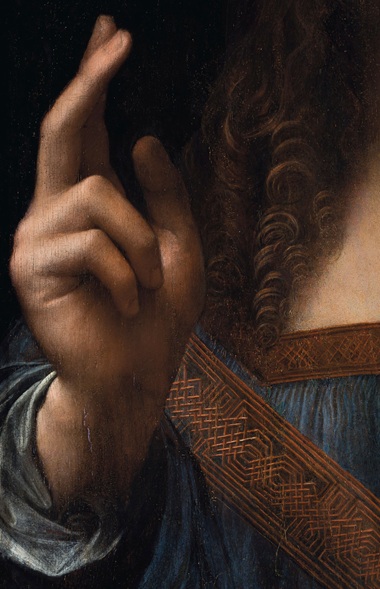 Infrared imaging reveals a first position for the thumb in the blessing hand, more upright than in the finished picture
Infrared imaging reveals a first position for the thumb in the blessing hand, more upright than in the finished picture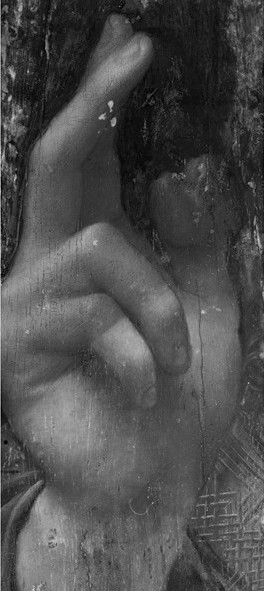 Infrared reflectography of pentiment in Christ’s blessing hand
Infrared reflectography of pentiment in Christ’s blessing handDuring the conservation process, pentimenti — preliminary compositional ideas, subsequently changed by the artist in the finished painting, but not reflected in the etching or painted copies — are observed through infrared imaging, and duly photographed. The most prominent is a first position for the thumb in the blessing hand, more upright than in the finished picture. IRR imagery also reveals distinct handprints, especially evident on the proper left side of Christ’s forehead, where the artist smoothed and blotted the paint with his palm. This kneading of the paint in order to create soft and amorphous effects of shadow and light is typical of the artist’s technique in the latter part of Leonardo’s career.
Other discoveries afforded by infrared analysis include the possibility that the head was executed with the aid of a cartoon; spolveri — pouncing — can be seen running along the line of the upper lip.
Two drawings comprising three sketches survive in which Leonardo studied the basic folds and disposition of Christ’s tunic and its sleeves. The two sheets are in the royal collections at Windsor Castle in England.
Technical examinations and analyses demonstrate the consistency of the pigments, media, and technique discovered in the Salvator Mundi with those known to have been used by Leonardo, especially in comparison to the Mona Lisa and St. John. As the possibility of the great master’s authorship becomes clear, the painting is shown to a group of international Leonardo scholars and experts, including Mina Gregori (University of Florence) and Sir Nicholas Penny (then, Chief Curator of Sculpture, National Gallery of Art, Washington, D.C.; subsequently Director of The National Gallery, London), so that an informed consensus about its attribution might be obtained.
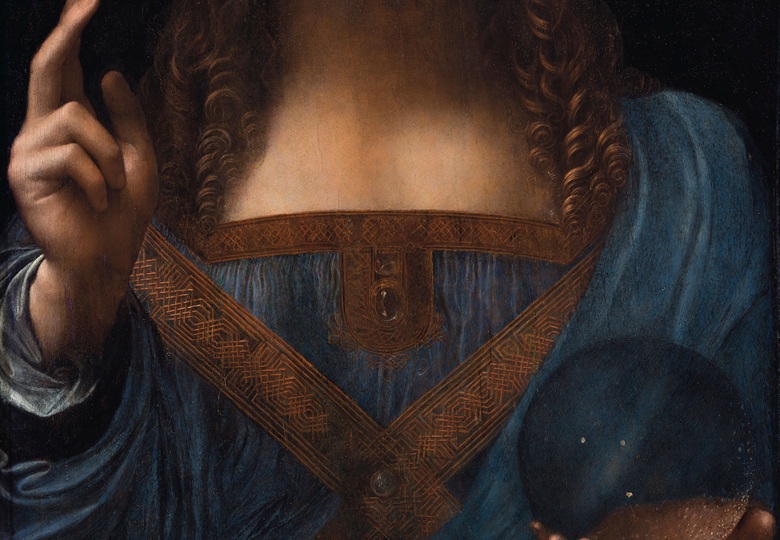
Leonardo da Vinci, Salvator Mundi, circa 1500 (detail)
2008
The painting is studied at The Metropolitan Museum of Art by museum curators Keith Christiansen, Andrea Bayer, Carmen Bambach, and Everett Fahy, and by Michael Gallagher, Head of Dept. of Paintings Conservation.
In late May, the painting is taken to The National Gallery, London, where it is studied in direct comparison with The Virgin of the Rocks, Leonardo’s painting of approximately the same date. David Allan Brown (Curator of Italian Painting, National Gallery of Art, Washington, D.C.), Maria Teresa Fiorio (Raccolta Vinciana, Milan), Luke Syson, the Curator of Italian Paintings at The National Gallery, Martin Kemp (University of Oxford), Pietro C. Marani (Professor of Art History at the Politecnico di Milano), and Carmen Bambach of the Metropolitan Museum of Art are among those invited to study the two paintings together. Later, the authenticity of the piece as an autograph work by Leonardo was confirmed by Vincent Delieuvin at the Louvre, Paris.
2010
The painting is again examined in New York by several of the above, as well as by David Ekserdjian (University of Leicester) and a broad consensus is reached that the Salvator Mundi was painted by Leonardo da Vinci, and that it is the single original painting from which the many copies and student versions depend.
The reasons for the unusually uniform scholarly consensus that the painting is an autograph work by Leonardo are several, including the previously mentioned relationship of the painting to the two autograph preparatory drawings in Windsor Castle; its correspondence to the composition of the ‘Salvator Mundi’ documented in Wenceslaus Hollar’s etching of 1650; and its manifest superiority to the more than 20 known painted versions of the composition.
Furthermore, the extraordinary quality of the picture, especially evident in its best-preserved areas, and its close adherence in style to Leonardo’s known paintings from circa 1500, solidifies this consensus.
Salvator Mundi is included in the landmark 2011-12 exhibition Leonardo da Vinci: Painter at the Court of Milan at the National Gallery in London
2011
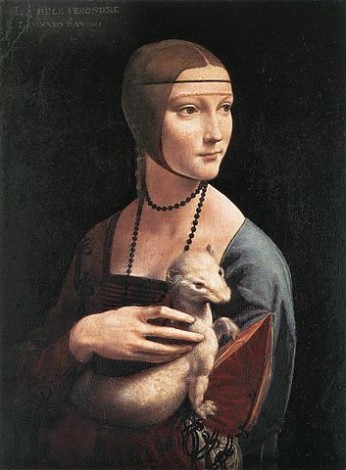
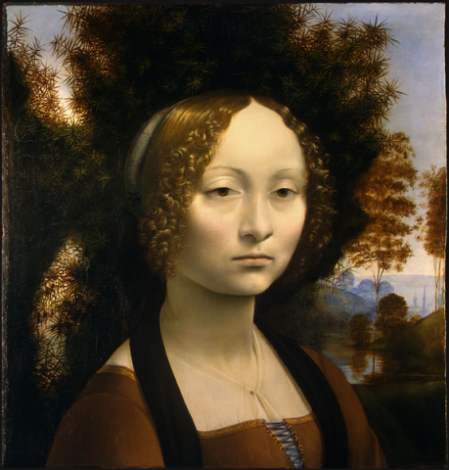
Salvator Mundi (‘Saviour of the World’) is unveiled in the exhibition Leonardo da Vinci: Painter at the Court of Milan at The National Gallery in London. One of 16 paintings in existence generally accepted as from the artist’s own hand, its inclusion in the exhibition comes after more than six years of research and inquiry to document its authenticity.
In the catalogue to the exhibition, curator Luke Syson presents the most insightful and broad-ranging examination of the painting yet.
2017
Celebrated author, Walter Isaacson, includes a chapter on Leonardo’s Salvator Mundi in Leonardo da Vinci, his biography of the artist.
2018
Margaret Dalivalle, Martin Kemp, and Robert Simon’s forthcoming book Leonardo’s Salvator Mundi and the Collecting of Leonardo in the Stuart Courts to be published by Oxford University Press.
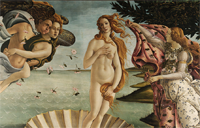
Posted by Virgin of the Rocks, London on Tue, 16 Jan 2018 11:43 | #
Virgin of the Rocks, London version